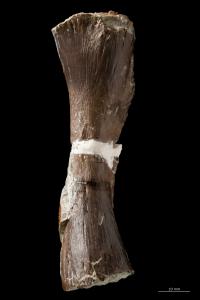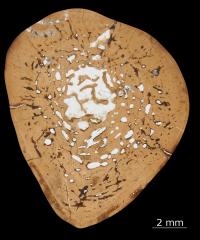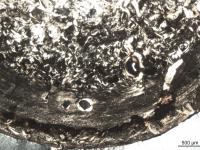
This is the femur of Metoposaurus diagnosticus krasiejowensis as viewed from behind (posterior). The sectioned plane is marked by the white stripe. Krasiejów, Poland was a vastly different place 230 million years ago during the Triassic Period. It was part of a giant continent called Pangea, had a warm climate throughout the year, and was populated by giant amphibians that weighed half a ton and were 10 feet long. Metoposaurus diagnosticus was one of these giant amphibians, and its environment had only two seasons: wet and dry. Like modern amphibians, Metoposaurus needed water for its lifestyle, but the extremely long dry season in Triassic Krasiejów drove this species to burrow underground and go dormant when water was scarce.
The burrowing behavior of Metoposaurus was recently discovered by Dorota Konietzko-Meier of the University of Opole, Poland and the University of Bonn, Germany, and P. Martin Sander also of the University of Bonn and was recently published in a study in the Journal of Vertebrate Paleontology. This study examined both the overall structure of the skeleton of Metoposaurus as well as the microscopic structure of its bones. 
This image shows microanatomy of the midshaft of Metoposaurus femur.
The broad, flat head, broad flat arm bones, wide hands, and large tail of Metaposaurus diagnosticus led the investigators to conclude that this species swam in ephemeral lakes during the wet season and used its broad, flat head and forearms to burrow under the ground when the dry season began. The authors also examined cross-sections of the bones of Metoposaurus looking for growth rings, called annuli. These annuli are similar to tree rings, where a band of light and a band of dark indicate one year of growth. In other early amphibians one annulus usually consists of a broad zone of rapid growth (wet season) followed by a thin band of slow growth (dry season), but in Metoposaurus, a period of prolonged slow growth was followed by a cessation of growth during the dry season. According to lead author Dorota Konietzo-Meier, "The histology of Metoposaurus long bones seems to be unique. In our interpretation it corresponds to the two-seasonal climate with a short, more favorable wet season and a long dry part of the year when life conditions were worse." 
The histology of the midshaft of Metoposaurus femur is visible using polarized light. Note the thick inner layer of more highly organized tissue (more uniform color), which is called an...
Dr. Michel Laurin from the Muséum National d'Histoire Naturelle who was not involved with this study, commented, "This interpretation is interesting, but problematic in some respects. This animal was much larger than any extant burrowing species I know of, and if it dug, I suspect that the snout and tail played a far greater role than the limbs, as we observe in most extant aquatic vertebrates."
These annuli also give an estimate of age. Co-author P. Martin Sander said, "A common problem with these large amphibians is that you can't tell from the shape of their bones if they are grown or not; sometimes the youngsters get described as a different species from the grown-ups". This technique solves that problem. It turns out that all of the specimens preserved at Krasiejów were juveniles. The smallest specimen was only one year old, while the largest specimen was four. Adulthood in these large amphibians was usually reached around year seven. The authors do not know if this mode of life was unique to juveniles or if adults also burrowed.
Sander concludes, "It amazes me time and again how much we can learn from these extinct animals. The techniques we used have been around since the 1840s, but only in the last 20 years have researchers asked the right questions and drawn comparisons with living animals."
Source : cmooneyhan@faseb.org
 Print Article
Print Article Mail to a Friend
Mail to a Friend
